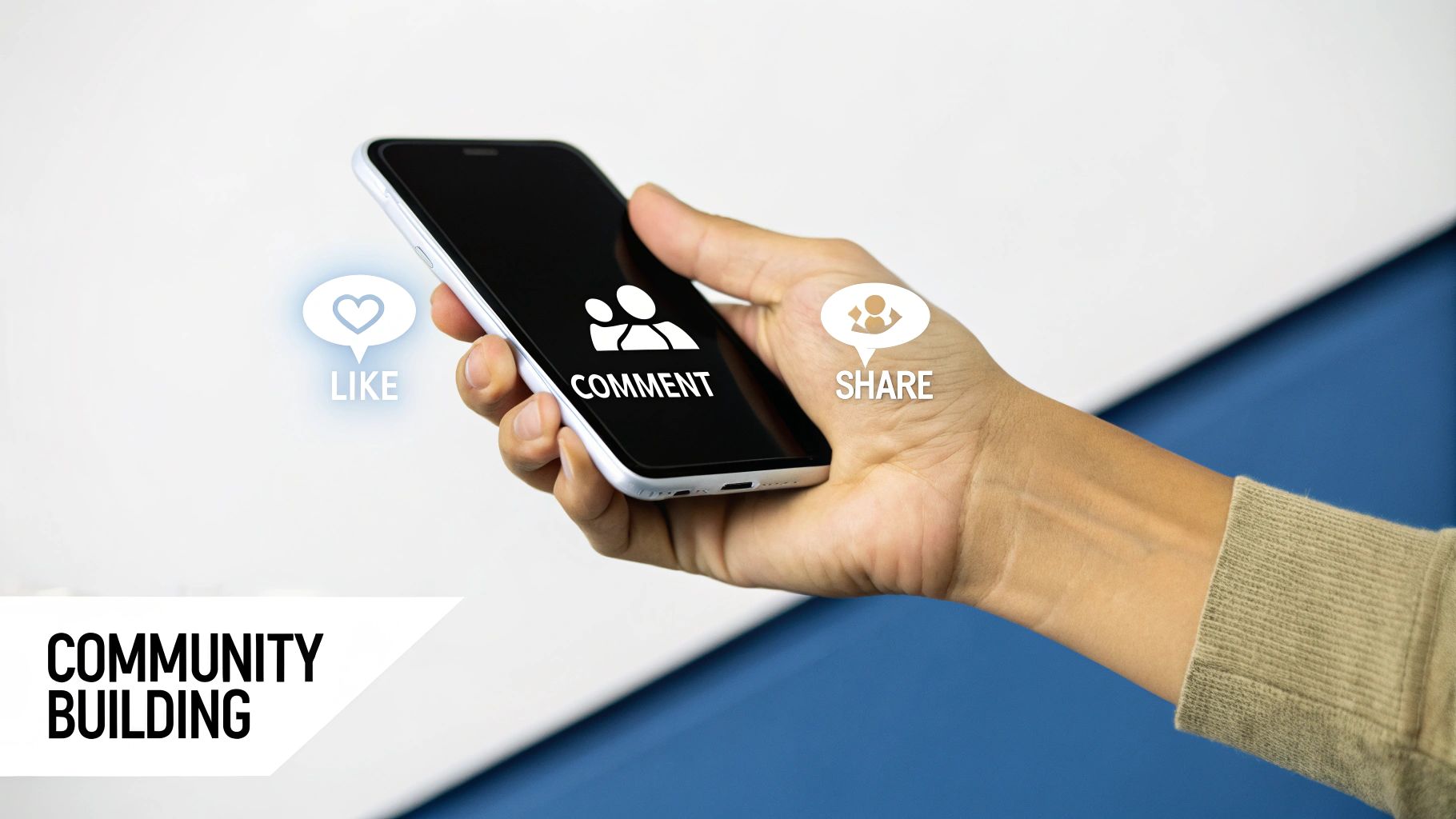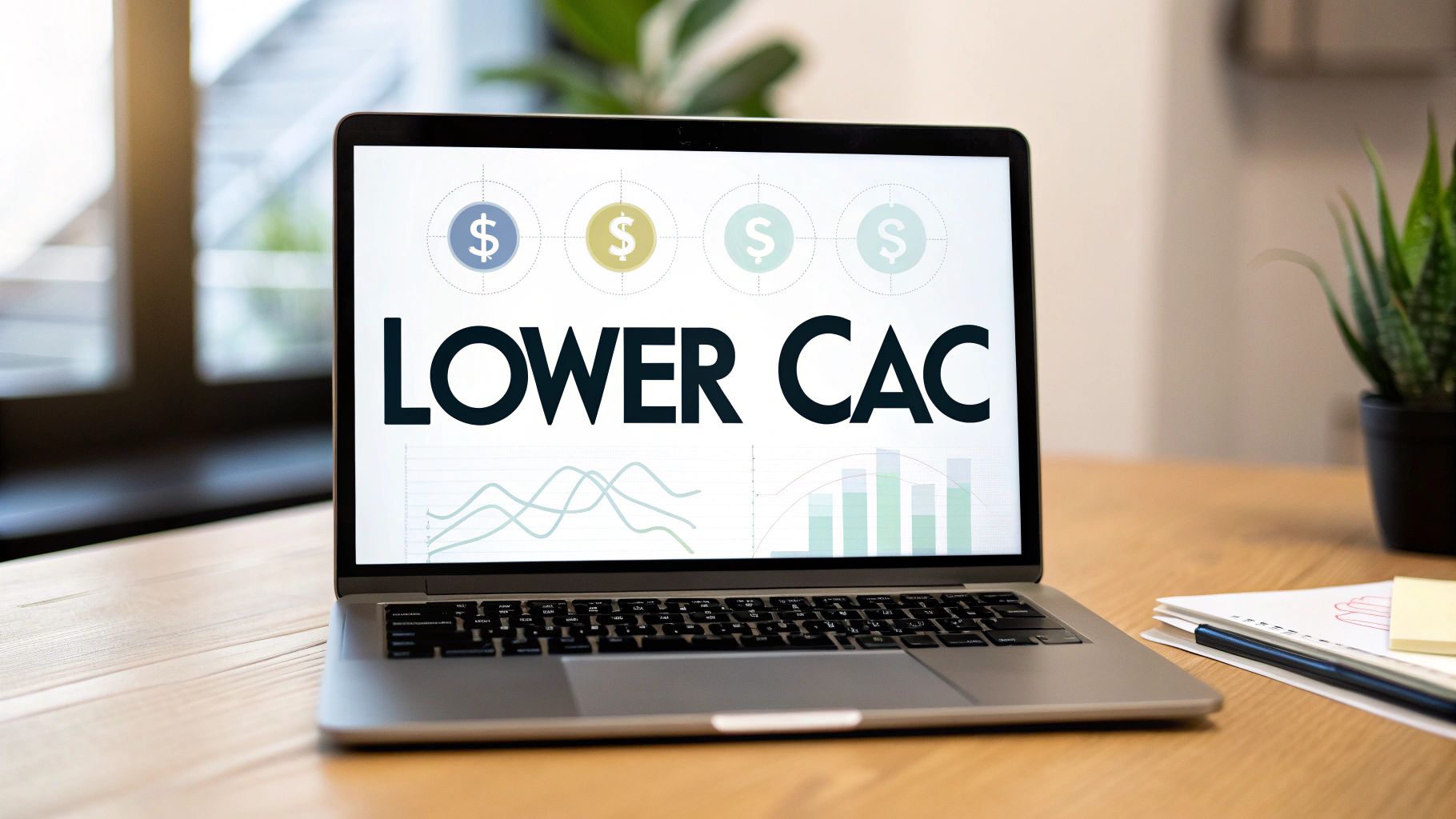Stop Burning Money: Smart CAC Reduction for 2025
Customer acquisition cost (CAC) is a critical metric for any startup. This listicle provides seven proven strategies to lower customer acquisition cost, allowing you to maximize your budget and achieve sustainable growth. Learn how to leverage organic content, referral programs, strategic partnerships, conversion rate optimization (CRO), email marketing, community building, and SEO to acquire customers more efficiently in 2025. These techniques will empower you to scale your business without breaking the bank.
1. Organic Content Marketing
Organic content marketing is a powerful strategy for lowering customer acquisition cost (CAC) by attracting and engaging potential customers naturally. Instead of relying on paid advertising, it focuses on creating valuable, relevant content that draws in your target audience through search engines, social media platforms, and direct sharing. This approach prioritizes building trust and authority with your audience, nurturing them through different stages of the buying journey organically. It's a particularly effective strategy for early-stage startups, self-serve SaaS companies, product-led growth SaaS, SaaS founders, and indie hackers looking for sustainable and cost-effective growth.

Organic content marketing encompasses various formats, including SEO-optimized blog posts and articles, educational videos and tutorials, engaging social media content, email newsletters and nurture sequences, and downloadable resources like ebooks and whitepapers. Each of these plays a crucial role in attracting, engaging, and converting potential customers without the need for expensive ad campaigns.
Examples of Successful Implementation:
Several successful companies demonstrate the power of organic content marketing. HubSpot, for instance, attracts millions of visitors monthly to its comprehensive marketing blog, establishing itself as a thought leader and generating leads organically. Buffer leverages social media resources to generate thousands of leads each month, demonstrating the platform's value through practical advice and insightful content. Shopify provides valuable e-commerce guides that effectively convert visitors into platform users. Mailchimp excels at using marketing automation content to drive user acquisition and educate its audience about email marketing best practices.
Why and When to Use Organic Content Marketing:
This approach is especially valuable for businesses with limited marketing budgets or those prioritizing long-term, sustainable growth. It's particularly effective in the early stages of a business when building brand awareness and establishing credibility are crucial. While paid advertising can deliver quick results, organic content marketing offers long-term compound returns on investment, building a valuable asset – your content library – that continues to attract and engage customers over time. It's also highly effective in industries where customers conduct extensive research before making a purchase, like SaaS and B2B.
Pros and Cons:
Pros:
- Long-term compound returns on investment: Content continues to work for you long after it’s published.
- Builds brand authority and trust: Valuable content positions you as an expert in your field.
- Lower direct costs compared to paid advertising: Reduce reliance on expensive ad campaigns.
- Creates lasting digital assets: Build a library of content that continues to attract customers.
- Improves search engine visibility: Drive organic traffic through effective SEO.
Cons:
- Requires significant time investment: Creating high-quality content takes time and effort.
- Results take months to materialize: Organic growth requires patience and consistency.
- Demands consistent content creation: Maintaining momentum is crucial for long-term success.
- Success depends on content quality and SEO knowledge: Understanding SEO best practices is essential for driving organic traffic.
Actionable Tips for Lowering CAC with Organic Content:
- Focus on solving specific customer problems: Address the pain points and challenges your target audience faces.
- Maintain a consistent publishing schedule: Regularly provide fresh content to keep your audience engaged.
- Optimize content for relevant keywords: Improve search engine rankings and attract organic traffic.
- Repurpose content across multiple channels: Maximize the reach and impact of your content.
- Track metrics like organic traffic and conversion rates: Measure the effectiveness of your content marketing efforts and identify areas for improvement.
Key Influencers:
The popularity of organic content marketing can be attributed to influential figures like HubSpot, pioneers of the inbound marketing methodology; Neil Patel, known for his expertise in SEO and content marketing; the Content Marketing Institute; and Rand Fishkin, a recognized authority on SEO and content strategy. Their contributions have shaped the landscape of online marketing and highlighted the importance of organic content in achieving sustainable growth.
By embracing organic content marketing, you can build a loyal audience, establish a strong brand presence, and significantly lower your customer acquisition cost, laying the foundation for long-term, sustainable success. It's a crucial strategy for any business, particularly startups and SaaS companies, seeking to maximize their marketing ROI and achieve sustainable growth.
2. Referral and Word-of-Mouth Programs
One of the most effective ways to lower customer acquisition cost (CAC) is by leveraging the power of existing customers through referral and word-of-mouth programs. These programs systematically incentivize satisfied customers to recommend your product or service to their network, tapping into the inherent trust and credibility that comes with personal recommendations. This organic approach allows you to acquire new customers at a significantly lower cost compared to traditional advertising methods, which can be particularly beneficial for early-stage startups, self-serve SaaS companies, and product-led growth SaaS businesses.

Referral programs work by offering rewards to both the referrer (the existing customer) and the referee (the new customer). This creates a win-win scenario, encouraging existing customers to spread the word and enticing new customers to try the product or service. These programs can be structured in various ways, including single-tiered rewards (a fixed reward for each successful referral) or multi-tiered structures where referrers earn increasingly valuable rewards as they bring in more customers.
Features that contribute to successful referral programs include easy-to-use sharing mechanisms, integrated social proof and testimonials, automated referral tracking, and streamlined reward distribution. These features minimize friction for both the referrer and the referee, making the process seamless and encouraging higher participation rates.
Numerous companies have demonstrated the immense power of referral programs. Dropbox’s famous "give storage, get storage" program fueled a phenomenal 3900% growth, showcasing the viral potential of a well-executed referral strategy. Similarly, Uber leveraged referral credits to rapidly expand its market share, offering discounts to both riders and drivers who referred new users. Tesla's referral program, offering exclusive rewards and experiences, further solidified the effectiveness of this strategy in driving customer acquisition. Even in its early days, PayPal used a simple $10 referral bonus to accelerate user growth, proving that even smaller incentives can yield substantial results. These success stories underscore the impact of referral programs across diverse industries and business models.
Implementing a successful referral program requires careful planning and execution. Here are some actionable tips for maximizing your results:
- Simplify the Process: Make referring as easy as possible. One-click sharing links and pre-written referral messages can significantly increase participation.
- Offer Valuable Rewards: Incentives should be attractive to both the referrer and the referee. Consider offering discounts, free trials, premium features, or exclusive content.
- Track and Optimize: Monitor referral sources, conversion rates, and overall program performance. Identify what works best and continuously refine your approach.
- Create Shareable Content: Develop compelling content and experiences that customers will naturally want to share with their network.
- Encourage Referrals: Proactively remind customers about your referral program through email marketing, in-app notifications, and social media campaigns.
While referral programs offer substantial benefits, it's crucial to understand the potential drawbacks. They require a base of satisfied customers to be effective, as dissatisfied customers are unlikely to recommend your product or service. Scaling a referral program can also be challenging without robust systems in place to manage tracking and reward distribution. Additionally, the cost of incentives can add up with successful programs, and there's a risk of attracting customers primarily motivated by rewards rather than genuine interest in the product.
Referral and word-of-mouth programs are particularly well-suited for early-stage startups and SaaS companies looking for cost-effective customer acquisition strategies. The inherent virality of these programs can significantly reduce reliance on expensive paid advertising, allowing businesses to reinvest their resources in product development and other growth initiatives. Learn more about Referral and Word-of-Mouth Programs. Companies like Dropbox and PayPal have demonstrated the transformative potential of referral marketing, paving the way for other businesses to leverage this powerful strategy. Tools like ReferralCandy, championed by growth experts like Andrew Chen, provide platforms and expertise to help businesses build and optimize their own referral programs. By understanding the mechanics of referral programs, implementing effective strategies, and continuously optimizing for success, businesses can unlock significant growth potential while keeping customer acquisition costs low.
3. Strategic Partnerships and Co-marketing
One of the most effective ways to lower customer acquisition cost (CAC) is through strategic partnerships and co-marketing. This approach involves collaborating with complementary businesses to share audiences, resources, and marketing efforts. By tapping into an established customer base and leveraging the credibility of a partner, companies can significantly expand their reach organically while sharing the associated costs. This makes it a particularly attractive strategy for early-stage startups, self-serve SaaS companies, and product-led growth SaaS businesses looking to scale efficiently.

Strategic partnerships can take many forms, offering a versatile toolkit for growth. These include:
- Cross-promotional campaigns and content: Partners can collaborate on blog posts, social media campaigns, email newsletters, and other content formats to expose their respective audiences to each other's offerings.
- Shared events and webinars: Co-hosting webinars or participating in joint events allows partners to share the costs of lead generation and reach a broader audience.
- Bundle offerings and joint products: Combining products or services into a bundled offering provides added value to customers and expands the potential market for both partners.
- Affiliate and partner referral programs: Incentivizing referrals through structured programs can generate a steady stream of new customers with relatively low acquisition costs.
- Co-branded marketing materials and campaigns: Jointly created marketing materials reinforce the partnership and offer a unified message to the target audience.
The advantages of this approach are numerous. Access to established, qualified audiences significantly reduces the time and resources needed to build brand awareness and generate leads, directly contributing to a lower customer acquisition cost. Shared marketing costs and resources further optimize spending. Moreover, associating with a reputable partner enhances credibility and builds trust, accelerating market penetration. This creates a mutually beneficial relationship where all parties contribute and derive value. Successful examples abound: Spotify partnering with Uber for personalized ride music, Starbucks and Barnes & Noble offering in-store coffee shops, GoPro and Red Bull collaborating on extreme sports content, and Slack and Dropbox integrating their platforms to drive mutual user growth. These demonstrate the power of synergistic partnerships in achieving significant market impact and lowering CAC.
However, strategic partnerships are not without potential drawbacks. Careful partner selection and vetting are crucial. Choosing the wrong partner can lead to brand dilution or misalignment, potentially damaging your brand image. Revenue sharing agreements, while enabling shared costs, can also reduce individual profit margins. Additionally, dependence on a partner's performance and reputation introduces an element of risk.
For SaaS founders and indie hackers, strategic partnerships can be a game-changer. However, maximizing their effectiveness requires a structured approach. Here are some actionable tips:
- Choose partners with complementary, not competing, offerings: Look for businesses that serve a similar target audience but offer products or services that enhance, rather than replace, your own.
- Establish clear partnership terms and expectations: A well-defined agreement outlining roles, responsibilities, and expected outcomes is essential for a successful partnership.
- Create mutually beneficial value propositions: Ensure that the partnership offers value to both businesses and their respective customers.
- Track and measure partnership ROI and attribution: Monitor key metrics to assess the effectiveness of the partnership and identify areas for improvement. Understanding which partnerships contribute most effectively to lower customer acquisition cost is critical.
- Maintain regular communication and relationship management: Nurturing the relationship with your partners is crucial for long-term success.
By following these tips and carefully considering the pros and cons, businesses can leverage the power of strategic partnerships to significantly lower customer acquisition cost, accelerate growth, and achieve sustainable success. This method deserves its place on this list because it offers a scalable and cost-effective way to reach new customers and build a strong brand presence, particularly valuable for resource-constrained startups striving for efficient growth. The shared resources, expanded reach, and enhanced credibility offered through strategic partnerships provide a potent combination for lowering CAC and fueling business expansion.
4. Conversion Rate Optimization (CRO)
Lowering customer acquisition cost (CAC) is a critical goal for any business, especially early-stage startups, self-serve SaaS companies, product-led growth SaaS, and indie hackers. One of the most effective strategies to achieve this is through Conversion Rate Optimization (CRO). Instead of pouring more money into attracting new visitors, CRO focuses on maximizing the value of the traffic you already have. By optimizing your website and marketing funnel, you can convert a higher percentage of visitors into paying customers, effectively lowering your CAC without increasing your traffic spend. This makes CRO a powerful lever for sustainable growth, particularly for businesses operating with limited resources.
CRO is a systematic process of improving your website and marketing funnel performance. It's about understanding user behavior, identifying friction points in the customer journey, and implementing data-driven changes to improve conversion rates. This isn't a one-time fix; it’s an ongoing cycle of testing, analyzing, and refining. Learn more about Conversion Rate Optimization (CRO)
How CRO Works:
CRO relies heavily on data and experimentation. Key components include:
- A/B and Multivariate Testing: This involves comparing different versions of a web page or marketing asset to determine which performs better. A/B testing compares two versions with a single variable changed, while multivariate testing compares multiple variations with several variables changed simultaneously.
- Landing Page Optimization: Your landing pages are often the first point of contact for potential customers. Optimizing elements like headlines, copy, images, call-to-actions (CTAs), and form fields can significantly impact conversion rates.
- User Experience (UX) and Design Improvements: A seamless and intuitive user experience is crucial for conversions. CRO focuses on removing any obstacles that might prevent visitors from completing desired actions, such as signing up for a trial or making a purchase. This includes simplifying navigation, improving page load speed, and ensuring mobile responsiveness.
- Form and Checkout Process Streamlining: A complicated or lengthy checkout process can lead to cart abandonment. CRO aims to simplify forms, reduce the number of steps required to complete a purchase, and offer various payment options.
- Analytics and Heat Mapping Tools: These tools provide valuable insights into user behavior, such as how visitors interact with your website, where they click, how far they scroll, and where they drop off. This data helps identify areas for improvement.
Real-World Success Stories:
Several organizations have demonstrated the power of CRO. For instance, the Obama 2012 campaign increased donations by a remarkable 49% through rigorous A/B testing of their email campaigns. Unbounce, a landing page optimization platform, boosted their own sign-ups by 30% simply by simplifying their landing pages. Visual Website Optimizer (VWO) has helped clients achieve an average of 23% conversion improvements across various industries. Even established companies like Basecamp saw a 30% increase in conversions by streamlining their signup process. These examples highlight the potential of CRO to drive significant improvements, regardless of company size or industry.
Actionable Tips for Implementing CRO:
- Start Small, Aim High: Begin with high-impact, low-effort tests. Focus on elements like headlines, CTAs, and form fields, as these can often yield significant improvements with minimal effort.
- Isolate Variables: Test one variable at a time to clearly understand the impact of each change. This avoids confusion and provides actionable insights.
- Statistical Significance: Ensure your test results are statistically significant before implementing changes. Use online calculators to determine if your results are due to actual improvements or random chance.
- Document Everything: Keep detailed records of your tests, including the hypotheses, variables tested, results, and learnings. This creates a valuable knowledge base for future optimization efforts.
- Learn from Failures: Not every test will be a winner. Analyze both successful and unsuccessful tests to understand what works and what doesn't. This iterative process is key to continuous improvement.
Pros and Cons of CRO:
Pros:
- Improves ROI on existing marketing spend.
- Provides data-driven insights about customer behavior.
- Compounds results across all traffic sources.
- Relatively quick to implement and test initial changes.
- Builds internal expertise and optimization processes.
Cons:
- Requires sufficient traffic volume for statistically significant results.
- Can be time-intensive to run proper tests and analyze data.
- May require specialized tools and expertise for advanced testing.
- Results can vary significantly by industry and target audience.
CRO is a valuable strategy for lowering customer acquisition cost by maximizing the value of existing traffic. By focusing on data-driven optimization, businesses can improve conversion rates, generate more customers from the same marketing budget, and achieve sustainable growth. While it requires a systematic approach and ongoing effort, the potential returns make CRO a worthwhile investment for any business focused on efficient growth.
5. Email Marketing and Lead Nurturing
For early-stage startups, self-serve SaaS companies, and product-led growth SaaS, lowering customer acquisition cost (CAC) is paramount. One of the most effective strategies for achieving this is email marketing and lead nurturing. This powerful approach focuses on building relationships with potential customers through targeted email campaigns that provide value and guide prospects through the buying journey. Instead of pushing for immediate sales, lead nurturing prioritizes educating and engaging your audience, converting interested prospects into customers over time through personalized communication. This allows you to build trust and demonstrate the value of your product or service before asking for a commitment, ultimately lowering your customer acquisition cost.
Email marketing excels at converting warm leads – individuals who have already expressed interest in your offerings. This could be through signing up for a free trial, downloading a resource, or subscribing to your newsletter. By segmenting these leads and providing them with relevant content through automated email sequences, you're effectively moving them down the sales funnel at a fraction of the cost of other acquisition channels.
The power of email marketing and lead nurturing lies in its personalization capabilities. Features such as automated email sequences and drip campaigns allow you to deliver the right message at the right time, based on a prospect's behavior and demographics. For example, you might send a series of onboarding emails to new free trial users, showcasing key features and benefits. Similarly, you could target prospects who abandoned their shopping cart with personalized reminders and incentives. Lead scoring and qualification systems help identify high-potential leads, allowing your sales team to prioritize their efforts and further personalize their outreach. Integration with CRM and sales processes streamlines communication and ensures a seamless customer experience.
The benefits of email marketing for lowering CAC are numerous. It boasts the highest ROI among digital marketing channels, often returning $36-42 for every $1 spent. This cost-effectiveness, combined with the ability to personalize at scale, makes it an ideal channel for startups and SaaS companies with limited budgets. Furthermore, email allows you to build relationships and trust over time, fostering long-term customer loyalty. Finally, the measurable and trackable nature of email campaigns allows for continuous optimization and refinement of your strategies.
Successful implementations of email marketing and lead nurturing abound. Mailchimp, a pioneer in the email marketing space, effectively uses educational email series to convert free users to paid subscribers. Airbnb sends personalized travel recommendations that drive bookings, while Grammarly's writing tips emails subtly lead users towards premium subscriptions. Shopify, a leading e-commerce platform, leverages educational email series to convert prospects into paying users. These examples highlight the versatility and effectiveness of email in driving conversions across various industries.
Despite its advantages, email marketing comes with its challenges. Building a quality email list is essential, as is avoiding the dreaded spam folder. Emails can be perceived as intrusive if not done well, requiring careful consideration of content and frequency. Consistent content creation and management are also crucial for maintaining engagement and driving results.
To maximize the effectiveness of your email marketing efforts and lower customer acquisition cost, consider the following tips:
- Segment your audience based on interests and behavior: This allows for more targeted and relevant messaging, increasing engagement and conversion rates.
- Create valuable, educational content rather than just promotional material: Focus on providing value to your audience, establishing yourself as a trusted resource.
- Test subject lines, send times, and email formats: A/B testing helps optimize your campaigns for maximum impact.
- Use behavioral triggers for automated sequences: Triggered emails based on user actions provide timely and relevant information, further nurturing leads.
- Clean your email lists regularly to maintain deliverability: Removing inactive or bounced email addresses improves your sender reputation and ensures your messages reach their intended recipients.
Pioneers and experts in the field of email marketing, such as Mailchimp, ConvertKit (specifically catering to creators), Ryan Deiss (founder of DigitalMarketer), and Ann Handley (a renowned email marketing and content expert), have demonstrated the power of this channel for driving growth and lowering CAC. Learn more about Email Marketing and Lead Nurturing. By implementing these strategies and best practices, you can effectively leverage email marketing to nurture leads, build lasting relationships, and ultimately lower your customer acquisition cost. This makes email marketing an essential tool for any early-stage startup, self-serve SaaS company, or product-led growth SaaS looking to thrive in a competitive market.
6. Social Media Community Building
Social media community building is a powerful strategy for lowering customer acquisition cost (CAC) by fostering organic growth and word-of-mouth marketing. It involves creating engaged communities around your brand on various social platforms where customers and prospects can interact, share experiences, and naturally discover your products or services. Instead of focusing on direct selling, this approach prioritizes building genuine relationships and cultivating organic advocacy, transforming satisfied customers into brand ambassadors. This organic approach is particularly valuable for early-stage startups, self-serve SaaS companies, product-led growth SaaS, SaaS founders, and indie hackers looking for cost-effective growth strategies.

This method deserves a place on any list focused on lowering CAC because it shifts the focus from expensive paid advertising to building a sustainable, organic growth engine. By nurturing a loyal community, you're essentially creating a self-perpetuating marketing cycle. Satisfied customers become advocates, attracting new customers through their testimonials and shared experiences. This significantly reduces reliance on paid channels and contributes to a lower CAC over time.
The core components of effective social media community building include consistent, value-driven content sharing; active engagement and community management; user-generated content campaigns; social listening and customer service; and strategic influencer and advocate partnerships. By consistently delivering valuable content tailored to your target audience, you attract and retain their attention. Active engagement through responding to comments, answering questions, and participating in discussions builds rapport and fosters a sense of belonging within the community. Encouraging user-generated content creates a sense of ownership and amplifies your brand message organically. Social listening allows you to identify relevant conversations and participate meaningfully, while providing excellent customer service builds trust and loyalty. Finally, partnering with relevant micro-influencers or brand advocates can extend your reach and credibility within your niche.
Many brands have successfully leveraged community building to lower their CAC and achieve significant growth. Glossier, the community-driven beauty brand, built a beauty empire largely through engaging with its target audience on Instagram. Peloton utilizes Facebook communities to drive customer retention and acquisition, fostering a sense of camaraderie among its users. Sephora's Beauty Insider community generates millions in sales through exclusive content, early access to products, and a vibrant online forum. Nike's running communities on multiple platforms cultivate brand loyalty and encourage organic sharing of fitness journeys.
To effectively implement social media community building, focus on providing value rather than overtly selling your product. Respond promptly and authentically to comments and questions, demonstrating genuine interest in your audience. Create shareable, visually appealing content that resonates with your target demographic. Utilize social listening tools to identify and join relevant conversations, positioning your brand as a helpful resource within the community. Collaborate with micro-influencers in your niche to expand your reach and leverage their existing audience.
While social media community building offers significant benefits, it's crucial to acknowledge the potential drawbacks. Building and managing a thriving community requires a significant investment of time and resources. Directly attributing results to revenue can be challenging, as the impact is often indirect and builds over time. Platform algorithm changes can affect organic reach, requiring ongoing adaptation and strategy adjustments. There’s also the risk of negative feedback becoming public, requiring proactive community management and crisis communication strategies.
Despite these challenges, the long-term benefits of social media community building for lowering CAC are substantial. By fostering genuine connections, encouraging organic advocacy, and building brand loyalty, this approach creates a sustainable growth engine that can significantly reduce reliance on expensive paid advertising channels. This makes it an invaluable strategy for early-stage startups and SaaS companies looking to achieve sustainable, cost-effective growth. For those willing to invest the time and resources, the rewards can be significant, translating into a loyal customer base, increased brand awareness, and a significantly lower CAC.
7. Search Engine Optimization (SEO)
Search Engine Optimization (SEO) is a powerful, long-term strategy for lowering customer acquisition cost (CAC) by attracting organic traffic from search engines like Google. It involves optimizing your website's content, structure, and authority to rank higher in search results for relevant keywords. Instead of paying for each click through advertising, SEO captures high-intent prospects actively searching for solutions you offer, effectively lowering your cost per acquisition. This makes it an especially attractive strategy for early-stage startups, self-serve SaaS companies, product-led growth SaaS, SaaS founders, and indie hackers working with limited budgets.
SEO works by aligning your website with what search engines deem valuable and relevant to user queries. When a user searches for a specific term (keyword), search engines crawl the web, analyzing websites based on various factors like content quality, relevance, site structure, and authority. The websites deemed most relevant and authoritative are then ranked higher in the search results, increasing their visibility and the likelihood of clicks.
For example, imagine a SaaS startup offering project management software. By optimizing their website for keywords like "project management software," "team collaboration tools," or "task management app," they can attract potential customers actively searching for those solutions. The higher they rank for these keywords, the more organic (free) traffic they receive, driving down their reliance on paid advertising and ultimately, their customer acquisition cost.
Successful Implementations:
Several companies have leveraged SEO effectively to achieve remarkable growth and lower customer acquisition cost:
- Zappos: In their early days, Zappos focused on long-tail keywords like "brown leather men's dress shoes size 10" instead of highly competitive terms like "shoes." This strategy allowed them to rank higher for specific searches, capturing highly qualified traffic and driving conversions.
- Canva: Canva ranks for thousands of design-related keywords, attracting millions of users searching for design tools and templates. This organic visibility has been instrumental in their rapid growth and market dominance.
- HubSpot: HubSpot's vast library of marketing resources consistently ranks for key business terms, establishing them as a thought leader and driving a significant volume of organic traffic to their website.
- Healthline: Healthline dominates the health and medical search landscape by consistently producing high-quality, informative content optimized for relevant keywords, driving a massive amount of organic traffic.
Actionable Tips for Lowering Customer Acquisition Cost with SEO:
- Focus on Long-Tail Keywords: Instead of targeting highly competitive keywords, focus on long-tail keywords (longer, more specific phrases) with lower competition. This allows you to rank higher faster and attract highly qualified traffic. For example, instead of "CRM," target "CRM for small businesses with e-commerce integration."
- Create Comprehensive, High-Quality Content: Provide valuable, in-depth content that answers user queries thoroughly. This not only improves your search rankings but also establishes you as a trusted resource in your industry.
- Optimize for User Intent: Understand what users are looking for when they search for specific keywords and tailor your content to meet their needs. Don't just focus on keywords; focus on providing relevant and helpful information.
- Build Authoritative Backlinks: Earn backlinks from reputable websites in your industry. Backlinks act as votes of confidence, signaling to search engines that your website is a trustworthy source of information. Create valuable content that others will naturally want to link to.
- Monitor and Improve Page Loading Speed and Mobile Experience: A slow-loading website and poor mobile experience can negatively impact your search rankings. Ensure your website is optimized for speed and mobile devices.
Pros and Cons of SEO for Lowering Customer Acquisition Cost:
Pros:
- Captures High-Intent, Qualified Traffic: SEO attracts users actively searching for solutions you offer, leading to higher conversion rates.
- Provides Long-Term, Compound Returns: SEO efforts can continue to generate organic traffic for years to come, providing a significant return on investment.
- Builds Credibility and Trust with Users: Ranking high in search results establishes your brand as a credible and trustworthy source of information.
- Cost-Effective Once Rankings are Achieved: While initial SEO efforts require investment, organic traffic is essentially free, significantly lowering your CAC in the long run.
- Works 24/7 Without Ongoing Ad Spend: Unlike paid advertising, SEO works around the clock, generating leads and customers even while you sleep.
Cons:
- Results Take Time: SEO is not a quick fix. It can take several months (3-6 or longer) to see significant results.
- Requires Ongoing Maintenance and Updates: SEO is an ongoing process. You need to consistently create new content, optimize existing content, and adapt to algorithm changes.
- Algorithm Changes Can Affect Rankings: Search engine algorithms are constantly evolving, and updates can sometimes impact your rankings.
- Competitive Keywords Can Be Difficult to Rank For: Ranking for highly competitive keywords can be challenging and require significant effort.
Popularized By:
Key figures in the SEO world who have helped shape best practices and understanding include:
- Rand Fishkin (Moz founder and SEO expert)
- Brian Dean (Backlinko founder)
- Neil Patel (SEO and digital marketing expert)
- Google Search Central (official SEO guidance - developers.google.com/search/central)
By implementing a well-defined SEO strategy, you can attract a consistent stream of organic traffic, significantly lowering your customer acquisition cost and fueling sustainable business growth. This is especially crucial for startups and indie hackers looking to maximize their limited resources and build a strong online presence. SEO is an investment that, while requiring patience and ongoing effort, can deliver substantial returns in the long run.
7 Strategies for Lowering Customer Acquisition Cost
| Strategy | 🔄 Implementation Complexity | 🛠️ Resource Requirements | 📊 Expected Outcomes | 💡 Ideal Use Cases | ⭐ Key Advantages |
|---|---|---|---|---|---|
| Organic Content Marketing | Medium to High - requires consistent, quality content creation and SEO skills | Moderate - skilled content creators, SEO tools | Long-term traffic growth and brand authority; results in months | Brands aiming for sustainable inbound traffic and authority | Long-term ROI; builds trust and assets; cost-effective long-term |
| Referral and Word-of-Mouth Programs | Medium - needs system setup and customer base | Moderate - referral platform, rewards budget | High conversion rates; viral growth potential | Businesses with existing satisfied customers wanting organic expansion | High trust-driven conversions; lower acquisition costs |
| Strategic Partnerships and Co-marketing | Medium to High - partner vetting and coordination required | Moderate to High - joint efforts, shared resources | Faster market reach and credibility enhancement | Companies seeking new audiences via complementary brands | Cost-sharing, expanded reach, mutual value creation |
| Conversion Rate Optimization (CRO) | Medium - testing setup and analysis required | Moderate - tools for analytics, experimentation | Improved conversion rates and ROI; relatively quick wins | Websites/funnels with existing traffic wanting better performance | Maximizes current traffic value; data-driven improvements |
| Email Marketing and Lead Nurturing | Medium - requires ongoing campaign management and list building | Moderate - email platform, content creation | High ROI; nurturing prospects into customers over time | Businesses focusing on relationship building and repeat sales | Personalization at scale; measurable and cost-effective |
| Social Media Community Building | High - demands consistent engagement and moderation | High - community managers, content creation | Increased brand loyalty and organic advocacy | Brands aiming to foster customer engagement and advocacy | Builds emotional bonds; organic word-of-mouth marketing |
| Search Engine Optimization (SEO) | Medium to High - technical and content optimization needed | Moderate - SEO expertise, tools | Sustainable organic traffic and high-intent leads | Websites targeting long-term organic visibility and traffic | Long-term, cost-effective traffic with high intent searchers |
Ready to Slash Your CAC and Supercharge Growth?
Lowering customer acquisition cost (CAC) is crucial for the sustainable growth of any business, especially for early-stage startups, self-serve SaaS companies, and those focused on product-led growth. We've explored seven powerful strategies to achieve this, from leveraging organic content and the power of referrals to optimizing your conversion rates and harnessing the potential of SEO. Mastering these approaches isn't just about saving money; it's about building a robust, efficient acquisition engine that fuels long-term success. To effectively lower your CAC, you need to understand how it's calculated. Check out this comprehensive guide on how to calculate customer acquisition cost from ECORN.
The key takeaway here is that lowering your CAC is an ongoing process of experimentation and optimization. By consistently implementing these strategies and adapting them to your specific business needs, you can significantly reduce your acquisition costs and free up resources to invest in other critical areas of growth. Remember, acquiring customers efficiently is a cornerstone of any successful business, and these strategies provide a solid foundation for achieving just that.
Want to further amplify your customer acquisition efforts and significantly lower your CAC? Refgrow empowers you to transform your existing users into a powerful acquisition channel with its embeddable affiliate software. Supercharge your growth by leveraging the network effect and watch your customer base expand efficiently.

